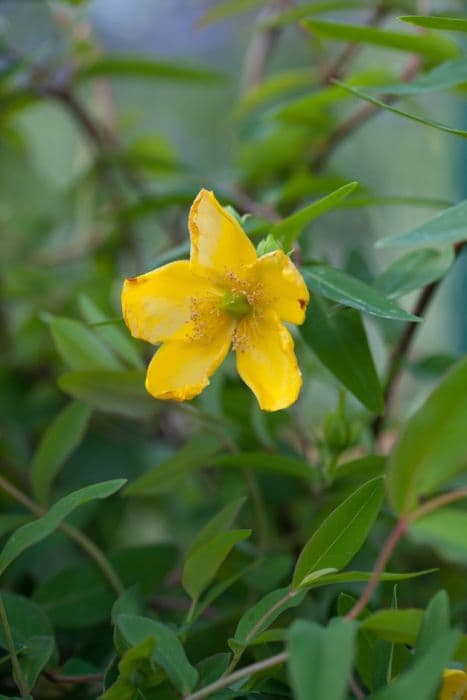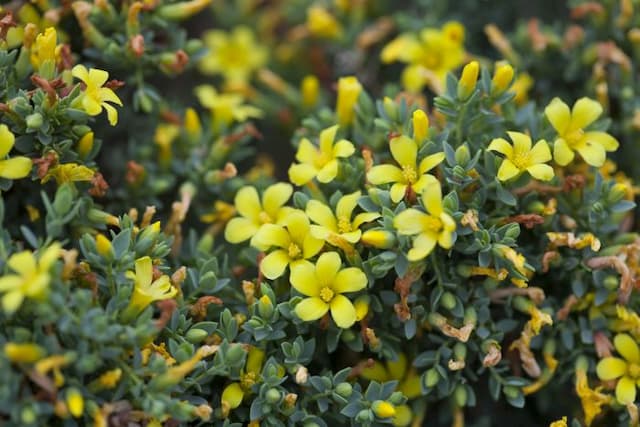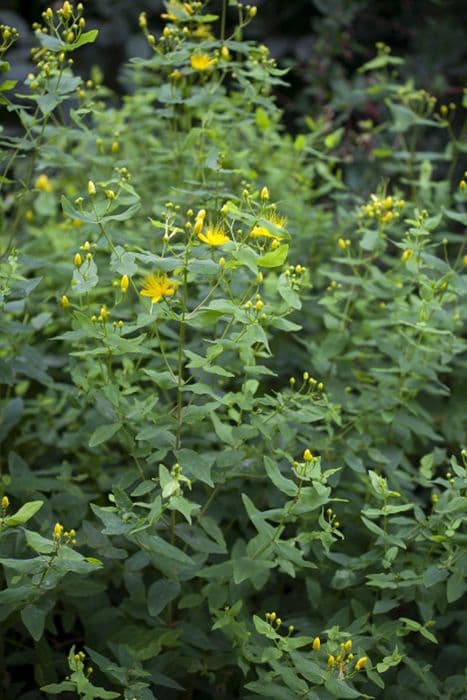Rose of Sharon Hypericum calycinum
ABOUT
Commonly known as Rose of Sharon or Aaron's beard, this plant is a low-growing, stoloniferous shrub. The leaves of the plant are dark green, glossy, oval-shaped, and arranged in opposite pairs along the stems. As for the flowers, they are particularly showy and large, usually a bright yellow color with a burst of prominent, bushy stamens in the center which adds to their ornamental appeal. These cup-shaped flowers blanket the plant throughout the summer, catching the eye of many garden enthusiasts. The plant has a woody, branching base and spreads easily where it’s allowed to grow freely. Its overall shape can be quite dense and bushy, providing a good ground cover and giving a full, lush appearance in the garden. The foliage may remain evergreen or semi-evergreen in mild winter climates, contributing to the landscape even when not in bloom.
About this plant
 Names
NamesFamily
Hypericaceae
Synonyms
Aaron's Beard, Rose Of Sharon, Creeping St. John's Wort, Great St. John's Wort
Common names
Androsaemum calycinum, Ascyreia calycina, Hypericum patulum, Hypericum grandiflorum, Sarothra calycina.
 Characteristics
CharacteristicsLife cycle
Perennials
Foliage type
Evergreen
Color of leaves
Green
Flower color
Yellow
Height
1-2 feet (30-60 cm)
Spread
1-2 feet (30-60 cm)
Plant type
Shrub
Hardiness zones
5-9
Native area
Southeastern Europe, Turkey
Benefits
 General Benefits
General Benefits- Low Maintenance: Hypericum calycinum, commonly known as Rose of Sharon, is a hardy plant that requires minimal care once established.
- Drought Tolerance: It can withstand periods of dry weather without needing frequent watering.
- Erosion Control: Its dense growth habit helps to prevent soil erosion on slopes or embankments.
- Attractive Groundcover: The plant provides a lush, green carpet that can quickly fill in large areas and suppress weeds.
- Long Flowering Season: Rose of Sharon boasts a long blooming period, providing bright yellow flowers from early summer to fall.
- Wildlife Habitat: Its flowers attract pollinators such as bees and butterflies, supporting local biodiversity.
- Winter Interest: When planted en masse, its evergreen leaves provide a dash of green color even in the winter landscape.
 Medical Properties
Medical Properties- Antidepressant: Hypericum calycinum is related to St. John's Wort (Hypericum perforatum) which is known for its use in treating mild to moderate depression.
- Anti-inflammatory: May contain compounds that help reduce inflammation, which could be helpful in treating conditions where inflammation is a factor.
- Antiviral: Some species of Hypericum are studied for their potential antiviral properties, which might also be present in Hypericum calycinum.
- Antibacterial: Extracts from plants in the Hypericum genus have shown antibacterial activity in scientific studies.
- Wound healing: Hypericum species have been traditionally used to promote the healing of wounds, which could suggest potential use in skin health and healing.
 Air-purifying Qualities
Air-purifying QualitiesThis plant is not specifically known for air purifying qualities.
 Other Uses
Other Uses- Rosary component: Aaron's beard plant material, especially its seeds, is sometimes used to make beads for rosaries and other ornamental objects due to their shape and hardness.
- Natural dye source: The flowers and other parts of Aaron's beard can be used to produce natural dyes for fabric and materials, offering a range of colors including yellows and browns.
- Decorative pressed flower art: The brightly colored petals of Aaron's beard are suitable for pressed flower crafts, adding vibrant hues to decorative pieces.
- Insect-repelling properties: Some gardeners use Aaron's beard as a companion plant, as it's believed to have properties that may repel certain insect pests from the garden.
- Photography subject: Due to its aesthetic appeal, Aaron's beard is often used by photographers as a subject for nature photography and botanical studies.
- Landscape rehabilitation: Aaron's beard is used in landscape rehabilitation projects for ground stabilization and erosion control because of its dense and rapidly spreading growth.
- Eco-friendly packaging: Dried parts of the plant, like the leaves, can sometimes be used as a natural, biodegradable filler material for packing sensitive items.
- Groundcover for shady areas: In landscaping, Aaron's beard is used as a groundcover plant in shady areas where other plants might struggle to thrive.
- Perfume industry: The fragrant oils extracted from Aaron's beard can sometimes be used in the perfume industry as part of aromatic blends.
- Cultural and religious symbolism: Aaron's beard has cultural significance in certain regions and can be used in religious ceremonies and cultural festivals as a symbol of protection or healing.
Interesting Facts
 Feng Shui
Feng ShuiThe St. John's Wort is not used in Feng Shui practice.
 Zodiac Sign Compitability
Zodiac Sign CompitabilityThe St. John's Wort is not used in astrology practice.
 Plant Symbolism
Plant Symbolism- Protection: Hypericum calycinum, commonly known as Rose of Sharon, has been historically used in folk medicine and believed to ward off evil spirits, which contributes to its association with protection.
- Healing: Due to its use in traditional medicine for its anti-inflammatory and antidepressant properties, the Rose of Sharon symbolizes healing and the alleviation of suffering.
- Good Luck: Carrying a charm or amulet made from parts of the Rose of Sharon was once thought to bring good luck and prosperity.
- Cheerfulness: The bright yellow flowers of the Rose of Sharon are often associated with brightness and positivity, symbolizing cheerfulness and optimism.
 Water
WaterAaron's beard, commonly known as Hypericum calycinum, requires consistent moisture, especially in hot, dry periods. Water the plant deeply once or twice a week, providing about 1 to 1.5 gallons of water each time, depending on weather conditions. During the first growing season, establish a good root system with regular watering. Once established, Aaron's beard is quite drought-tolerant but will benefit from additional water during prolonged dry spells. Avoid overhead watering to prevent leaf problems, and instead, water at the base of the plant.
 Light
LightAaron's beard thrives in full sun to partial shade. The plant will produce its best flowering in full sun but can also tolerate and bloom in partial shade. Too much shade can lead to fewer flowers and a leggier growth habit, so aim for a spot that receives a good amount of daily sunlight.
 Temperature
TemperatureAaron's beard is hardy in a range of temperatures and can tolerate a winter low down to around 10°F without significant damage. It grows well in a temperature range from 50°F to 90°F but can withstand occasional spikes above this range in summer. Ideal growing conditions are within the aforementioned temperature range.
 Pruning
PruningPrune Aaron's beard in early spring to shape the plant and remove any dead or damaged wood. Pruning can also be done to encourage bushier growth. Prune again lightly after the first significant bloom, which typically encourages a second bloom later in the season. Best time for pruning is when new growth starts to appear.
 Cleaning
CleaningAs needed
 Soil
SoilAaron's Beard thrives in well-drained soil with a pH of 5.5 to 7. The ideal soil mix should be rich in organic matter, so incorporating compost or peat moss into the garden soil would be beneficial. Ensuring proper drainage is crucial, so adding perlite or sand can help prevent water-logging.
 Repotting
RepottingAaron's Beard does not require frequent repotting as it is often grown as a ground cover. It may be divided or repotted every 2 to 3 years to manage its spread and rejuvenate its growth, particularly in a garden setting.
 Humidity & Misting
Humidity & MistingAaron's Beard prefers moderate to high humidity levels but is quite adaptable and can tolerate a wide range of humidity conditions. They are generally resilient and do not require any special humidity adjustments when planted outdoors.
 Suitable locations
Suitable locationsIndoor
Provide bright light and well-draining soil.
Outdoor
Plant in part sun, well-draining soil, water regularly.
Hardiness zone
5-9 USDA
 Life cycle
Life cycleAaron's beard, or Hypericum calycinum, begins its life cycle as a seed, which germinates in moist, well-draining soil in spring to early summer. The seedling emerges and develops into a small plant with distinctive glossy, green leaves and a fibrous root system. During its vegetative stage, it grows vigorously, spreading through stolons to form a dense ground cover. Aaron's beard reaches maturity and begins flowering in mid-summer, producing bright yellow flowers with numerous stamens. After pollination, typically by insects, the flowers develop into capsule-like fruits containing numerous small seeds. The plant becomes dormant in winter but is evergreen in milder climates, with growth resuming in early spring, completing the cycle.
 Propogation
PropogationPropogation time
Spring to early summer
Hypericum calycinum, commonly known as Aaron's beard, can be propagated most effectively through semi-hardwood cuttings. The best time to take these cuttings is during the late summer, after the plant has finished blooming and the new growth has begun to mature. To propagate, select a healthy stem that has some new growth but is starting to become firm. Cut a section of stem about 4 to 6 inches (10 to 15 centimeters) long, making sure there are at least two or three sets of leaves. Remove the leaves from the lower half of the cutting to expose the nodes, as roots will develop from these points. Dip the cut end into a rooting hormone to encourage root development and plant the cutting in a mix of half peat and half perlite or sand to provide good drainage. Keep the soil moist but not soggy and place the pot in a warm area with indirect sunlight. With proper care, the cuttings will root in a few weeks, and you can transplant them to their permanent location in the garden the following spring.









